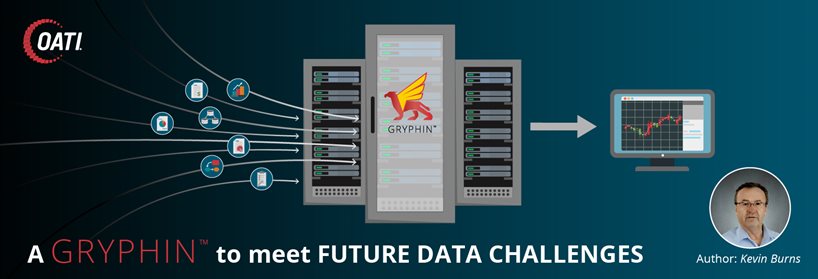Home » Blog » Grid Modernization » A Gryphin™ to Meet Future Data Challenges
A Gryphin™ to Meet Future Data Challenges
With help from a Gryphin, OATI is taking on Big Data and the Internet of Things (IoT). A Gryphin (also known as Griffin, Griffon, and Gryphon) is a mythological man-bird-beast with the head and wings of an eagle, and the body, tail, and hind legs of a lion. As a well-known symbol for protection and agility, the legendary Gryphin has been associated and used for different purposes over the centuries. For the Persians, Gryphins were guardians of light; in other observations, Gryphin guarded treasures like gold.
So what does a Gryphin have to do with Big Data and IoT? For starters, the IoT is the concept of connecting everything to the Internet in some way, including smartphones, tablets, cars, refrigerators, and thermostats. There is a lot of new and valuable data generated through IoT. By connecting this data together, information becomes more useful and evolves into Big Data, or large datasets that typical software tools have difficulty processing and managing in a reasonable amount of time. Consumption of the data by Gryphin makes it possible for the information to be used while it is in motion (i.e. real-time messages), as well as when it is at rest (i.e. from a database). True to its namesake, the nimble Gryphin™ will make this information easily accessible to applications to meet the needs of OATI customers.
Comprised of Open Source software tools, databases, messaging technologies, security structures, and development methodologies, Gryphin™ will provide customers with an accessible, performant, and resilient infrastructure for information management. Traditional computer architecture designs cannot cope with the scale and speed challenges facing modern applications; for example, handling large, complex datasets and complying with customers’ needs for affordable and fast data management.
When data is stored in a hierarchical data warehouse, it is separated into files or folders, and the original data records are lost, so businesses lose information that could be valuable for analysis and future decisions. Essentially, traditional data systems were not built to take advantage of the commodity storage and processing power available today. Like a guardian of data, Gryphin™ utilizes a data lake — a storage repository — which holds a vast amount of data using data structures that correspond to the nature of the information. These types of data structures allow for time and space representations like time-series data. They also include the IoT (i.e. ‘things’, including smart devices, meters, assets, locations, etc.), documents with records and schedules about ‘things,’ and networks that are the relationships between ‘things.’
Customers are expecting ever-growing volumes of information, much of which is from the expansion of IoT devices and an increasing need to manipulate data to create detailed, timely information. While interacting with the familiar webOATI application, users will benefit from the underlying technologies of OATI Gryphin™ that allows applications to communicate with large databases and millions of external devices through OATI-selected Open Source technologies.
These Open Source products and solutions support highly performant, widely available Cloud infrastructures. By providing a path to meet the changing needs and requirements of customers and eliminating or reducing third-party licensing fees, OATI will remain cost competitive in its services and benefit from Big Data and IoT. OATI aspires to move away from dependencies created with proprietary technologies and products. We are embracing new, modern architectural principles offering Cloud-based applications in a fault-tolerant infrastructure designed for high scalability — the ability to grow under increased demand — and extreme performance.
OATI as a Software-as-a-Service (SaaS) provider shares application servers among multiple client tenants thus potentially lowering operational costs. In the SaaS software delivery model, each user accesses software resources remotely and acquires flexible application customizations. As a framework of the future, Gryphin™ can provide the benefits of various levels of customization and configuration.
Although Gryphin™-based applications are being developed and deployed, legacy applications will gradually take advantage of the infrastructure, in either whole or part, through a managed evolution. With proposals sent out, service solution pilots commencing, and aggressive new development occurring, the first flight of OATI Gryphin™ is expected very soon.
About the Author:
Mr. Kevin Burns is an Account Executive for OATI and the President of TranServ International, an independent provider of transmission management and power system study services. Mr. Burns has over 35 years of experience in electric utility operations, information systems development and support, and software sales. Mr. Burns holds a BA degree from the University of Minnesota.
- September 4, 2018
